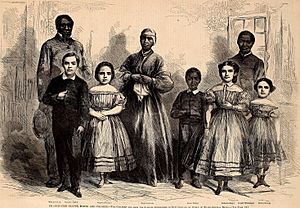Wilson Chinn facts for kids
Quick facts for kids
Wilson Chinn
|
|
|---|---|
| Known for | Subject of photos demonstrating instruments of torture, widely circulated during the American Civil War |
Wilson Chinn (fl. 1863) was an enslaved American man who escaped to freedom. He became well-known because of powerful photographs. These pictures showed the terrible treatment he received while enslaved.
One famous photo showed Chinn, who was from Louisiana. He had the initials "V.B.M." branded onto his forehead. These were the initials of his owner, Volsey B. Marmillion. He also wore a special collar used for punishment. This photo, along with others showing tools used to hurt enslaved people, became very popular. It was shared widely by the abolitionist movement. This movement worked to end slavery during the American Civil War. Even today, it is one of the most famous photos from that time. A writer for The New York Times said these images were "as disturbing today as they were in 1863." They showed how new photography could change history.
Escape to Freedom
Wilson Chinn was about 60 years old when he escaped. He was first raised in Kentucky. When he was 21, he was sold and taken to Louisiana. There, he worked for Volsey B. Marmillion on a sugar plantation. Marmillion often branded the people he enslaved. Wilson had the letters "V.B.M." burned into his forehead.
One day, 105 enslaved people from Marmillion's plantation escaped together. They made their way to a Union army camp. Thirty of them had been branded like cattle. Four had brands on their foreheads, and others on their chests or arms.
George H. Hanks, a colonel in the Union army and a supporter of civil rights, helped these people. He worked with Mr. Phillip Bacon. Bacon had started the first school for formerly enslaved people in Louisiana.
Sharing the Story
After escaping, Wilson Chinn and other formerly enslaved people traveled North. They went from New Orleans to cities like New York City and Philadelphia. Among them were four children who looked very light-skinned. There was also a boy named Isaac, who was eight years old and Black.
In these cities, they posed for photographs. These pictures were printed on small cards called carte de visite. They were sold for twenty-five cents each. The money raised from selling these photos went to help educate formerly enslaved people in Louisiana. Each photo clearly stated that the money would "be devoted to the education of colored people."
Many of these photos were taken by photographers Charles Paxson and Myron Kimball. Their group photo later appeared as a woodcut in Harper's Weekly. This was a very popular magazine during the Civil War.
In January 1864, Harper's Weekly published an article about Chinn and the children. This helped spread the anti-slavery message even further. The powerful images and stories helped people understand the cruelty of slavery.
Where to See the Photos Today
In recent years, the famous "branded slave" photo of Wilson Chinn has been shown in art museums. These include:
- The Metropolitan Museum of Art in New York City (April 2 – September 2, 2013).
- Gibbes Museum of Art (September 27, 2013 – January 5, 2014).
- New Orleans Museum of Art (January 31 – May 4, 2014).


